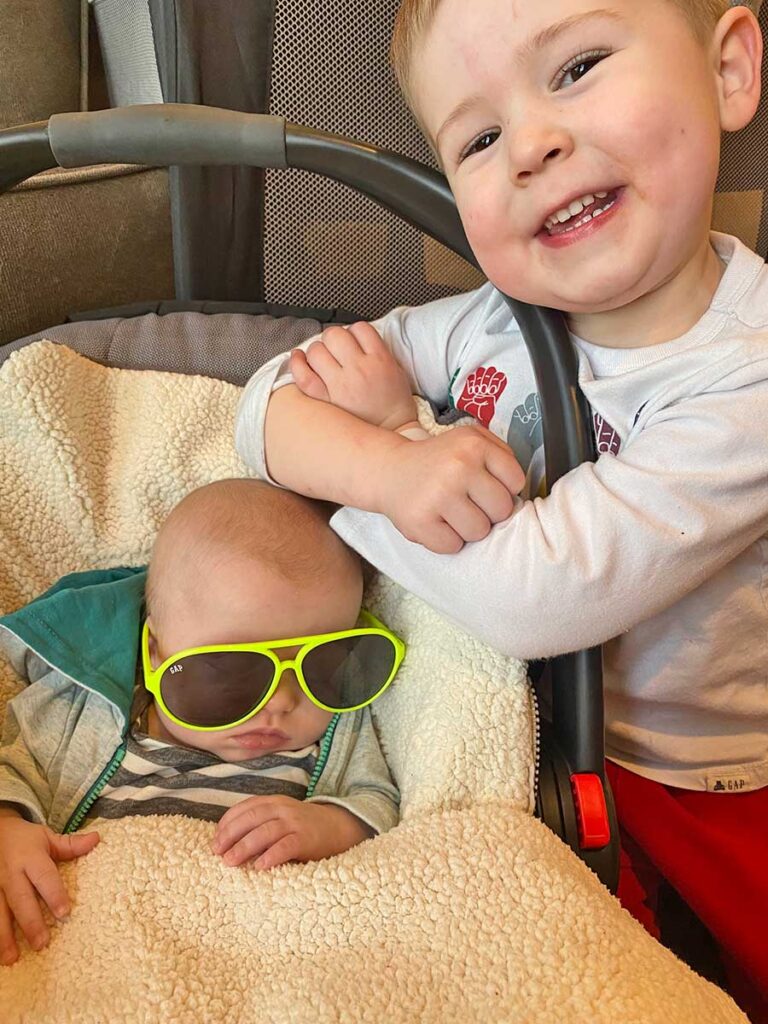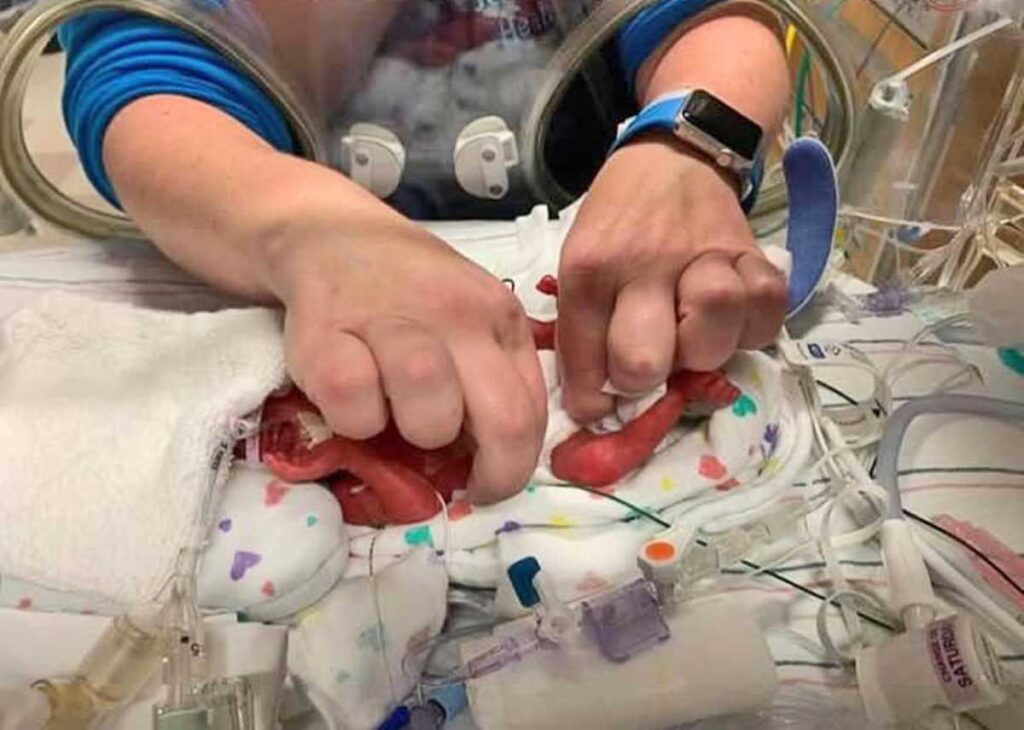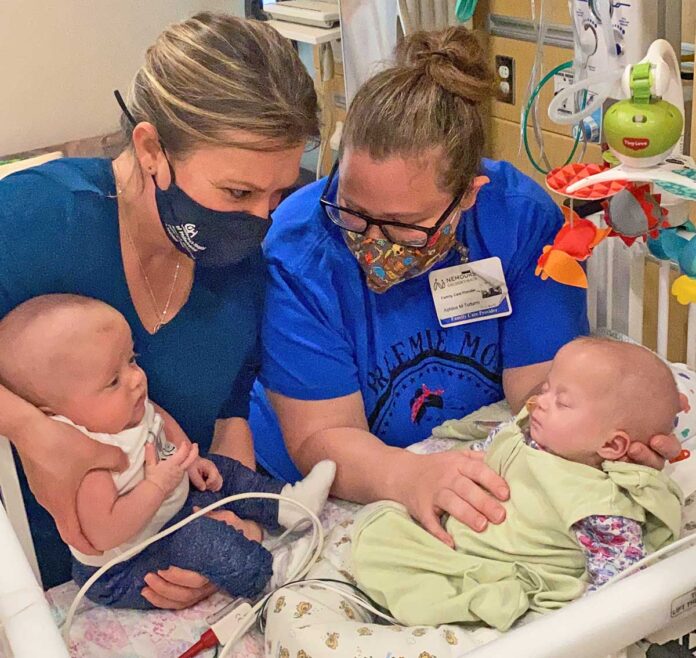After I found out I was expecting twins, I immediately turned to Google to see what was in store for us. One of the most universal pieces of advice I found was that twins are often born prematurely, so get ready for them to be early. Okay, Ashlee and I thought, we’re always early, too, so piece of cake!
When the twins were born 12 weeks early, we got a crash course in prematurity, starting from our jarring first look at our 1- and 3-pound babies. Every day over the last four-and-a-half months, we’ve developed new understanding of just what it means to be premature — both for babies and their families — allowing us to deconstruct some of the misconceptions we had heard about prematurity.

1. Being early means you just have to grow.
Before prematurity touched our family, neither Ashlee nor I had ever really known much about it, so, gearing up for our own early additions, we naively simplified the experience to mean that the twins would just need some extra time to grow. Sure, they’d be small and, sure, they’d have some work to do, but preemiehood is mostly just a waiting game for the kiddos to put on the pounds and catch up in growth.
That falsehood makes the preemie process sound passive when, as we’ve seen, it’s an extremely active experience — these babies are not just laying around soaking up calories and waiting to get bigger. In our case, the twins were born right at the start of the third trimester, which should be when the vast majority of development happens in utero: massive brain growth, kidney and lung development, the sharpening of auditory and vision capabilities, and usually about the gaining of about half of their birth weight.
Preemies have to spend those last few weeks or months where they should still be in utero in an unnatural place (the NICU, for most), and that creates inherent challenges to their growth and development. While high-tech isolettes do their best to mimic the environment preemies should be in, they’re not quite the real thing, and many preemies have significant complications that far transcend weight gain. Our two, for instance, have encountered prematurity-related issues including hydrocephalus, retinopathy, intestinal tears, lung collapses, holes in the heart and more.
2. It’s a numbers game.
We also were under the impression that there were some hard and fast rules about preemies and the NICU. In the anxiety-filled weeks and months leading up to the twins’ delivery, after we found out Avery had intrauterine growth restriction (poor fetal growth that can be caused by a range of things; for her, it was likely placental insufficiency) we were living by the numbers. At each biweekly growth scan, the doctors grimly shared that Avery had dropped to the 3rd percentile for growth, then the 2nd, then the 1st, then off the charts. We were devastated by the calculations: How could a baby estimated in the .001 percentile for her age and weight survive?
Thankfully, we joined an IUGR Facebook group that was filled with success stories of babies who thrived after being born at less than the 1st percentile. We also took heart when Avery finally crossed the coveted 500-gram threshold. Babies are considered to have the best chance of survival, and doctors are legally required to attempt to intervene to save their lives when they’re born, once they weigh 500 grams (17.5 ounces). Ultimately, Avery was born at 18 ounces.
But, we’ve since learned that, while such stats offer guideposts, they’re far from black and white. August, for instance, was released from the hospital earlier than other NICU babies he was surrounded by but who were born weighing more than he did. While the hospital experienced a loss of a baby less than 500 grams whose bed was next to his, one of Avery’s nurses mentioned she had previously cared for a baby who was born at only about 250 grams (9 ounces) and who went on to survive.
Similarly, we and many others were mistakenly under the impression that babies had to be at least 5 pounds to be released from the NICU (I can’t describe how many friends and neighbors have asked throughout this process for updates on if the twins had hit the magic 5-pound number yet!). Instead, NICUs focus less on weight and more on milestones, such as if they’re breathing independently, maintaining their blood sugars, and eating a certain percentage by bottle instead of through the feeding tube. That means some babies may go home before they hit 5 pounds and others, like ours, could have a longer stretch (August was discharged 2.5 months ago at 5 pounds, 13 ounces and Avery is still chugging along in the NICU at about 7 pounds).

3. Preemies are fragile and weak
When Avery was born, she weighed barely more than a water bottle and was the height of a piece of paper. Her skin was translucent and would tear with the removal of a bandage. Her eyes weren’t able to fully open yet. She was on a ventilator to keep her breathing. She looked like a small gust of wind would break her. But oh man, was she strong.
From day one, her grip on our fingers was impressive. At less than a week old, she made it her life’s mission to pull her breathing tube out—and made some good progress! Once, when she was about 4 pounds, she actually succeeded at ripping out her IV. She’s faced down surgery after surgery, breathing challenges, heart problems and so much more — she once had to have six minutes of chest compressions to keep her alive — and has come out the other side, even at her tiny size. While August’s medical complications have been far less significant, he’s shown just as much grit by nearly quadrupling his size since birth, mastering bottle feeding in record time and getting sprung from the NICU more than three weeks before his due date, which is the average time many preemies are discharged.
And their stories are in no way unique from other preemies. From NICU nurses to groups for preemie parents to books, we’ve heard so many stories about the incredible strength these babies have. “Tiny but mighty” may be a kitschy little saying emblazoned on many preemie onesies, but there’s some real truth to that.
4. “Be glad you didn’t have to deal with the third trimester.”
When the babies were born, I was just starting to experience the dreaded third-trimester swelling (though that was probably related to pre-eclampsia), back aches, leg cramps and more. A couple well-meaning observers have mentioned over the last few months that, while the twins’ prematurity is obviously no picnic, at least I didn’t have to endure the challenges of the third trimester or the work of a natural birth, as I had a C-section.
Yes, I’m not sad I stopped being pregnant in enough time that I could still somewhat see my feet under my belly. But I’d certainly take that time back in a second and bring on all the hardships that come with the last few months of a pregnancy to have the twins be born on time, and healthy.
5. They catch up by a certain date.
Witnessing a preemie grow can feel like you’re watching a horse race. You want them to get as big as they can as fast as they can and meet every single one of their milestones so they can go on to be neck and neck with all of the other babies their age and not have their birth story define their life. But, for many, it will to some degree.
While many preemies will be on par for development with full-term babies by their second birthday, that’s not an absolute, we’ve learned: Each baby “catches up” on their own timeline and in their own way. At the moment, August is sucking down bottles like a champ every two to three hours and his sister, born two minutes after him, is still on a feeding tube and just starting to experiment with the suck, swallow, breathe mechanism. Her retinopathy of prematurity, a common vision problem among preemies, cleared up by two months, while his persisted into his fourth. They both continue to deal with “disorganized” systems that can cause challenges for breathing, eating, motor skills and social interaction.
We’re learning to gear our expectations for development around a few different age markers that all preemies have:
- Gestational age: The week at which the baby is born, out of a 40-week expected gestation (the twins were 28+6). Viability is generally considered to start around week 24, with expectations for survival going up every week after.
- Actual/chronological age: Obviously! (Their birthdate was Nov. 11.)
- Adjusted age: This is the important one–the time that has elapsed since their expected due date. The twins were supposed to arrive Jan. 28, so as of this writing, they’re going on 8 weeks adjusted.
The adjusted age is what preemies will be measured against for everything from their growth chart to expectations around developmental milestones. Even though August and Avery were born in November, they were still supposed to be in utero, going through the third trimester at that point, so right now they should only be behaving and developing like 8-week-olds, instead of nearly 5-month-olds.
Along with this realization, we’ve had to dispel the misconception that preemiehood is left at the door of the NICU. Families with babies in intensive care build their entire lives around their babies’ discharge from the hospital: All of the work the babies are doing in the NICU and each success they have puts them one step closer to coming home. But while every NICU parent can’t wait to see the hospital doors in the rearview mirror, even if the babies are healthy enough to be released, that doesn’t mean the complications of prematurity are over.
We’re inching closer to Avery’s potential discharge and are facing the sobering reality of feeding tubes and outpatient surgeries and weekly therapies that are going to have to continue after we get her situated at home. Prematurity marked the beginning of the twins’ lives and, like many other babies born into this world too early, it’s going to continue to be a defining — though, as much as we can help it, not the defining — aspect of their lives.
